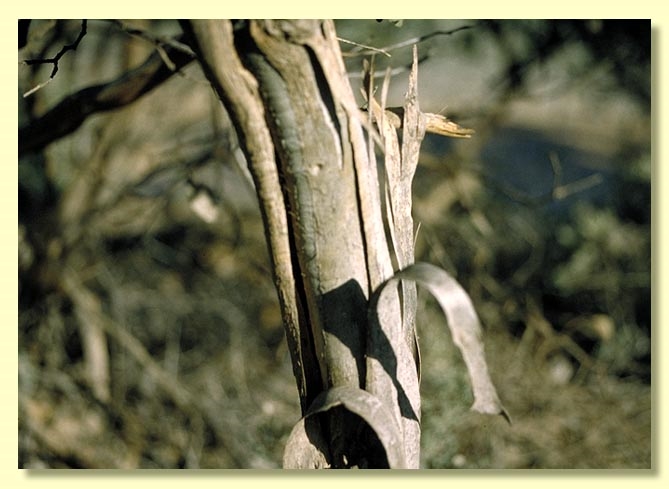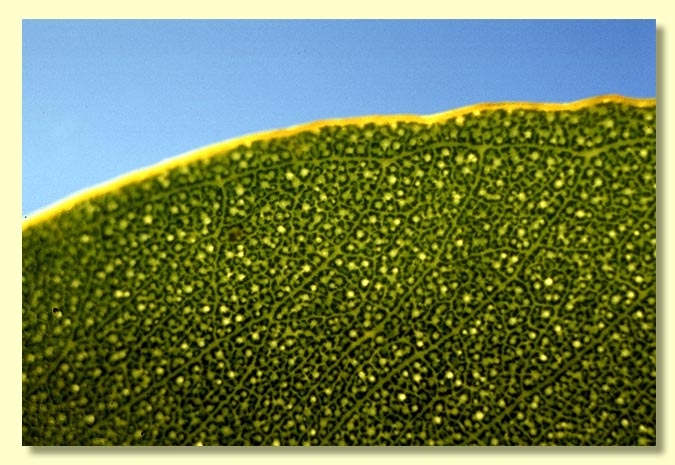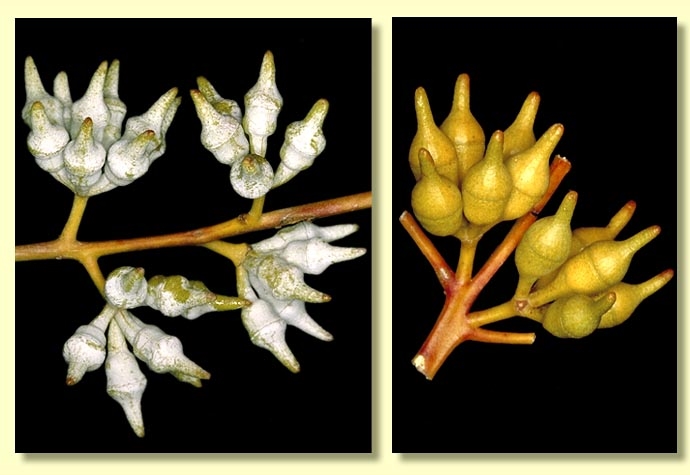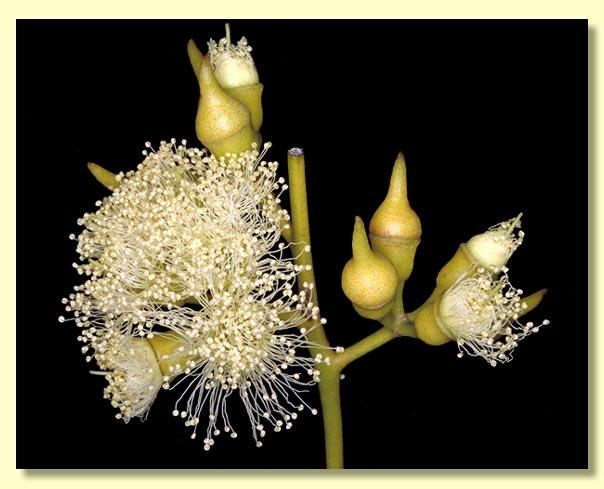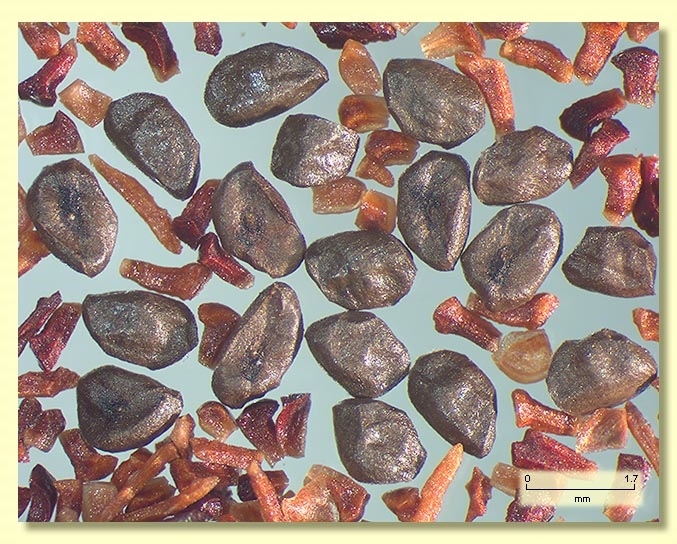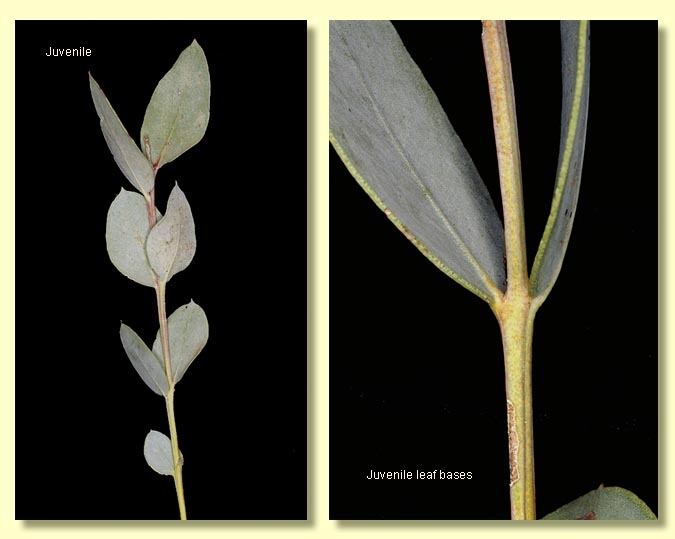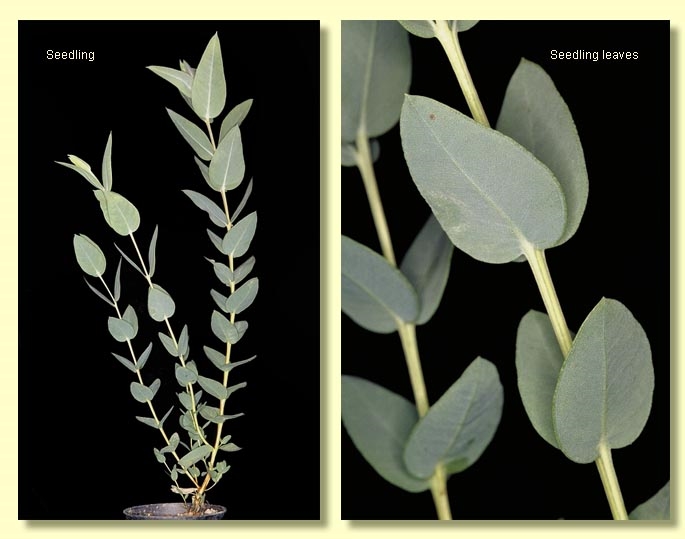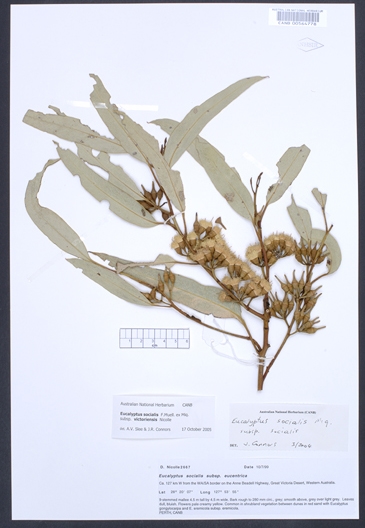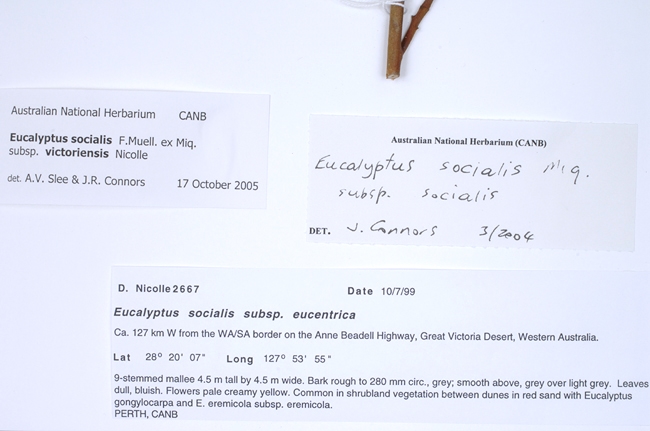Eucalyptus | Symphyomyrtus | Bisectae | Destitutae | Subulatae | Decussatae
Euclid - Online edition
Eucalyptus socialis subsp. victoriensis
Bark usually rough on the lower stem, occasionally smooth-barked to ground level, rough bark loose flaky, fibrous, ribbony, grey to brown, sometimes ribbons held in the upper branches; upper stem smooth-barked, grey over pale orange-brown.
Branchlets lacking oil glands in the pith.
Juvenile growth (coppice or field seedlings to 50 cm): stems square in cross-section and not glaucous; juvenile leaves opposite to alternate, sessile to shortly petiolate, ovate, 4–7.5 cm long, 2.5–3.5 cm wide, base rounded to tapering, dull grey-green (usually not glaucous).
Adult leaves alternate, petioles (1.2)1.5–3.4 cm long; blade broadly lanceolate to lanceolate, 5.5–10(13) cm long, (1.4)1.5–3(3.5) cm wide, concolorous, dull to rarely slightly glossy green, side-veins at an acute or wider angle to midrib, moderately to densely reticulate, oil glands intersectional.
Inflorescence axillary unbranched, peduncles (0.4)0.7–1.5(2) cm long, buds usually 9 or 11, rarely 7, pedicellate, pedicels 0.4–0.8 cm long. Mature buds ovoid to oblong (1.2–2 cm long, 0.5–0.8 cm wide), yellowish, rarely glaucous, scar present, operculum beaked (0.8–1.4 cm long), slightly wider than hypanthium at the join, stamens irregularly flexed, anthers versatile, globoid to cuboid, dehiscing by lateral pores, style long, stigma tapered, locules 3 or 4, the placentae each with 4 vertical ovule rows. Flowers creamy white to yellow.
Fruit pedicellate, pedicels 0.3–0.7 cm long, barrel-shaped to cup-shaped, 0.7–1.2 cm long, 0.7–1 cm wide, rarely glaucous, disc descending, valves 3 or 4, valve tips strongly exserted due to fragile style remnants.
Seeds brown to grey, 1.5–2.2(2.5) mm long, ovoid or flattened-ovoid, occasionally with shallow longitudinal furrows on otherwise smooth dorsal surface, hilum ventral.
Cultivated seedlings (measured at node 10): cotyledons Y-shaped (bisected); stems square in cross-section, usually not glaucous, sometimes slightly glaucous on new growth; leaves opposite, sessile, slightly cordate to ovate, 2–6.5 cm long, 1.3–2.7 cm wide, dull grey-green, sometimes with slightly glaucous new leaves, bases rounded to truncate to amplexicaul.
Flowering has been recorded in April, May, July, August, September and October.
Eucalyptus socialis is a species of mallee widespread in mallee-lands in southern Australia, also in the Great Victoria Desert and in numerous other desert sites north-west to the Pilbara of Western Australia, north and north-east to Central Australia and, disjunctly, in central Queensland. The stems are rough-barked or smooth, the buds are prominently beaked and seedling leaves are sessile and opposite on the square stem.
Eucalyptus socialis belongs in Eucalyptus subgenus Symphyomyrtus section Bisectae subsection Destitutae because buds have two opercula, cotyledons are Y-shaped and branchlets lack oil glands in the pith. Within this subsection E. socialis is part of the large taxonomic series Subulatae which is further characterised by globoid more or less basifixed anthers, grey smooth seeds with shallow longitudinal furrows, and fruit with fragile, prominently exserted style remnants. Series Subulatae is divided principally into four subseries based on the juvenile leaves: one subseries with spiral, crowded seedling leaf arrangement (subseries Spirales), another with decussate and decurrent seedling leaves (subseries Decurrentes), a third with decussate non-decurrent seedling leaves (subseries Decussatae), and a fourth with disjunct, petiolate seedling leaves (subseries Oleaginae).
Eucalyptus socialis is part of subseries Decussatae along with the following 7 species: E. aspersa, E. dolichocera, E. gillii, E. vokesensis, E. wyolensis, E. yalatensis and E. yumbarrana. Excepting for E. aspersa and E. dolichocera, the geographical range of E. socialis overlaps with that of the other species and often can be found growing quite nearby any of them.
E. socialis is most closely related to E. gillii, a species occurring in the northern Flinders Ranges of South Australia extending east into the Fowlers Gap area of New South Wales. E. gillii is considered by some botanists as a neotenous variant of E. socialis, differing from it by its crown of glaucous, sessile, cordate to ovate, juvenile leaves. E. yalatensis occurs within the southern range of E. socialis, crossing the Nullarbor Plain from Balladonia and Toolinna in Western Australia to the Eyre Peninsula and, disjunctly, Tailem Bend in South Australia, and differs from E. socialis its low spreading habit, small buds with a pointy operculum (no beak), small obconical fruit and in never being glaucous. E. yumbarrana, a South Australian endemic species related to and occurring within the range of E. socialis in the desert country north-west of Ceduna, differs in having thicker glossy adult leaves, buds with the operculum slightly wider than the hypanthium at the join and slightly larger fruit.
In the area of the Great Victoria Desert north-west of Ooldea two species closely related to E. socialis occur, E. vokesensis and E. wyolensis. Both are heavily glaucous on the new branchlets, buds and fruit. E. vokesensis has petiolate adult leaves forming the crown whilst E. wyolensis has a crown of sessile opposite large juvenile leaves; both species have buds larger than those of typical E. socialis.
The remaining two species in subseries Decussates, E. aspersa and E. dolichocera, are found immediately east and northeast of Perth, Western Australia. E. aspersa is a mallee occurring sporadically as understory in Jarrah forests in the Darling Range and differs from E. socialis in having smaller leaves, buds and fruit and in being non-glaucous. E. dolichocera occurs in the wheatbelt and is a large mallee with obvious rough bark, pendulous bud clusters, buds with prominently beaked operculum and is never glaucous.
Eucalyptus socialis has three subspecies:
E. socialis subsp. socialis
Very widespread, in New South Wales, Victoria, South Australia, extending to the Pilbara in Western Australia and to Central Australia, and, disjunctly, in central Queensland (sporadically from west of Winton and Longreach to north-east of Aramac). Subsp. socialis may be glaucous or not so, but always has dull leaves. Distinguished from subsp. viridans by these dull green adult leaves and from subsp. victoriensis by its smaller buds and fruit.
E. socialis subsp. victoriensis
A mallee from the southern part of the Great Victoria Desert, extending from Forrest Lakes in Western Australia near the border with South Australia, south-east to the Gawler Ranges and north-western Eyre Peninsula, particularly on dune crests or in swales between dunes. It has large buds with the operculum slightly wider than the hypanthium at the join, large fruit (0.7–1 cm wide) and has coarse, usually dull, rarely slightly glossy, adult leaves.
E. socialis subsp. viridans
It occurs in South Australia from the eastern side of the Eyre Peninsula through the Yorke Peninsula to the southern Murray Mallee, possibly extending into the western parts of Victoria. It is distinguished from subsp. socialis and subsp. victoriensis by its glossy adult leaves. It has been confused with E. peninsularis, a distantly related species endemic to the Eyre Peninsula, which can be easily identified by its decurrent juvenile leaves, pendulous prominently beaked buds and strongly urn-shaped fruit. In the absence of buds and juvenile leaves specimens of subsp. viridans have been misidentified as E. oleosa subsp. oleosa.
The taxonomy of E. socialis and related species is somewhat complex, not least due to the remote occurrences of some forms. The name E. eucentrica was published in 1991 by L.A.S. Johnson & K.D. Hill to account for plants occurring in the Great Victoria Desert, the Pilbara, Central Australia and Queensland, that had coarser leaves, larger buds that were often glaucous and yellow flowers, compared with more typical E. socialis. Relatively large-leaved E. eucentrica was regarded by Johnson & Hill as smaller than the non-glaucous glossy leaved E. yumbarrana. Nicolle (2005) re-classified E. eucentrica at subspecies level i.e. E. socialis subsp. eucentrica, differing from subsp. socialis by the glaucous branchlets and buds and the creamy yellow flowers. Nicolle also regards the subsp. eucentrica as occurring from the Pilbara east to the Simpson Desert and disjunctly in central Queensland, but occurring in South Australia only in the far-north-west, not in the Great Victoria Desert. Observations in the field and herbarium by the authors of EUCLID show that the variation in glaucescence is pronounced with non-glaucous and glaucous plants with similar sized leaves and buds growing side by side in some areas; degrees of glaucescence from none to slight to pronounced also occur within populations. For this reason we include Nicolle's subsp. eucentrica in subsp. socialis. Bud dimensions also suggest subsp. eucentrica is better placed in subsp. socialis than in subsp. victoriensis.
subsp. victoriensis: referring to its area of occurrence in the Great Victoria Desert, Western Australia and South Australia.


